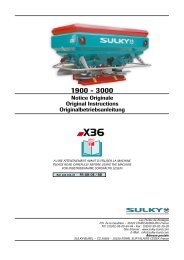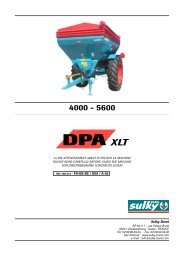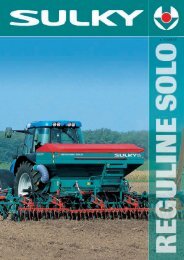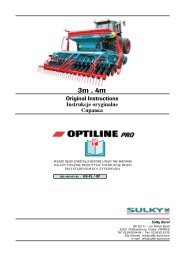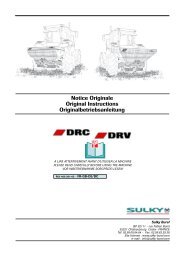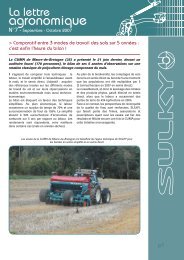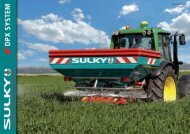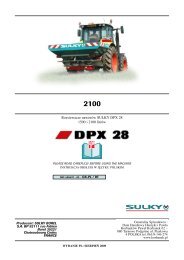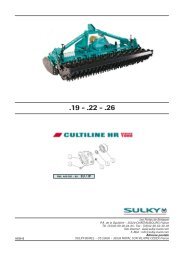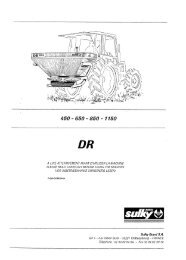1 - Sulky Burel
1 - Sulky Burel
1 - Sulky Burel
You also want an ePaper? Increase the reach of your titles
YUMPU automatically turns print PDFs into web optimized ePapers that Google loves.
GB<br />
shafts are properly guarded, both in the working<br />
position and in the transport position.<br />
4 - Before connecting or disconnecting a universal<br />
drive shaft, disengage the power take-off, turn off<br />
the engine and re-move the key from the ignition.<br />
5 - If the primary universal drive shaft is fitted with<br />
a torque limiter or a free wheel, these must be<br />
mounted on the machine power take-off.<br />
6 - Always ensure that universal drive shafts are<br />
fitted and locked correctly.<br />
7 - Always ensure that universal drive shaft guards<br />
are immobilized in rotation using the specially<br />
provided chains.<br />
8 - Before engaging power take-off, ensure that<br />
the speed selected and the direction of rotation of<br />
the power take-off comply with the<br />
manufacturer’s instructions.<br />
9 - Before engaging power take-off, ensure that<br />
no persons or animals are close to the machine.<br />
10 - Disengage power take-off when the universal<br />
drive shaft angle limits laid down by the<br />
manufacturer are in danger of being exceeded.<br />
11 - Caution! When power take-off has been<br />
disengaged, moving parts may continue to rotate<br />
for a few moments. Do not approach until they<br />
have reached a complete standstill.<br />
12 - On removal from the machine, rest the<br />
universal drive shafts on the specially provided<br />
supports.<br />
13 - After disconnecting the universal drive shafts<br />
from the power take-off, the protective cap should<br />
be fitted to the power take-off.<br />
14 - Damaged power take-off and universal drive<br />
shaft guards must be replaced immediately.<br />
HYDRAULIC CIRCUIT<br />
1 - Caution! The hydraulic circuit is pressurized.<br />
2 - When fitting hydraulic motors or cylinders,<br />
ensure that the circuits are connected correctly in<br />
accordance with the manufacturer’s guidelines.<br />
3 - Before fitting a hose to the tractor’s hydraulic<br />
circuit, ensure that the tractor-side and machineside<br />
circuits are not pressurized.<br />
4 - The user of the machine is strongly<br />
recommended to identify the hydraulic couplings<br />
between the tractor and the machine in order to<br />
avoid wrong connection. Caution! There is a<br />
danger of reversing the functions (for example:<br />
raise/lower).<br />
5 - Check hydraulic hoses once a year:<br />
. Damage to the outer surface<br />
. Porosity of the outer surface<br />
. Deformation with and without pressure<br />
. State of the fittings and seals<br />
The maximum working life for hoses is 6 years.<br />
When replacing them, ensure that only hoses with<br />
the specifications and grade recommended by the<br />
machine manufacturer are used.<br />
6 - When a leak is found, all necessary<br />
precautions should be taken to avoid accidents.<br />
7 - Pressurized liquid, particularly hydraulic circuit<br />
oil, may cause serious injury if it comes into<br />
contact with the skin. If the case of injury, consult<br />
a doctor immediately. There is a risk of infection.<br />
8 - Before any operation on the hydraulic circuit,<br />
lower the machine, release the pressure from the<br />
circuit, turn off the engine and remove the key<br />
from the ignition.<br />
MAINTENANCE<br />
1 - Before commencing any maintenance,<br />
servicing or repair work, or before attempting to<br />
locate the source of a breakdown or fault, it is<br />
essential that the power take-off is disengaged,<br />
the engine turned off and the key removed from<br />
the ignition.<br />
2 - Check regularly that nuts and screws are not<br />
loose. Tighten if necessary.<br />
3 - Before carrying out maintenance work on a<br />
raised machine, prop it up using appropriate<br />
means of support.<br />
4 - When replacing a working part (fertilizer<br />
spreader blade or seed drill coulter), wear<br />
protective gloves and only use appropriate tools.<br />
5 - To protect the environment, it is forbidden to<br />
throw away oil, grease or filters of any kind. Give<br />
them to specialist recycling firms.<br />
6 - Before operating on the electric circuit,<br />
disconnect the power source.<br />
7 - Protective devices likely to be exposed to wear<br />
and tear should be checked regularly. Replace<br />
them immediately if they are damaged.<br />
8 - Spare parts should comply with the standards<br />
and specifications laid down by the manufacturer.<br />
Only use <strong>Sulky</strong> spare parts.<br />
9 - Before commencing any electric welding work<br />
on the tractor or the towed machine, disconnect<br />
the alternator and battery cables.<br />
10 - Repairs affecting parts under stress or<br />
pressure (springs, pressure accumulators, etc.)<br />
should be carried out by suitably qualified<br />
engineers with special tools.<br />
DANGER<br />
❶<br />
❷<br />
❶ Rotating agitator<br />
❷ Hydraulic pressure<br />
❸ Rotating disc<br />
Projection of fertilizer<br />
❹ Risk of pinching or crushing<br />
❹<br />
❸<br />
4




